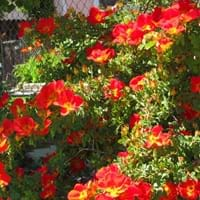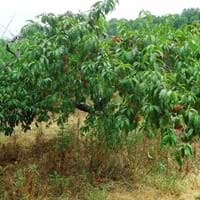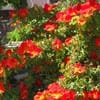Life Span
Perennial
Annual
Type
Flowering Plants, Ornamental Plants, Shrubs
Fruit
Origin
Not Available
China
Types
Not Available
Yellow peach, White peach, Clingstone
Number of Varieties
Not Available
Habitat
Foot Hills
Warmer regions
USDA Hardiness Zone
Not Available
5-9
AHS Heat Zone
Not Available
9-1
Sunset Zone
Not Available
H1, 1a, 1b, 2a, 2b, 3a, 3b, 6, 7, 8, 9, 10, 11, 12, 13, 14, 15, 16, 18, 19, 20, 21, 22, 23, 24
Habit
Clump-Forming
Oval or Rounded
Flower Color
Orange Red, Yellow
Red, Green, Light Green, Yellow
Flower Color Modifier
Bicolor
Bicolor
Fruit Color
Non Fruiting Plant
Yellow
Leaf Color in Spring
Green
Pink
Leaf Color in Summer
Green, Dark Green
Green
Leaf Color in Fall
Dark Green
Green
Leaf Color in Winter
Dark Green
Light Green
Leaf Shape
Pinnate
Long, simple, curved and folded
Plant Season
Spring, Summer, Fall
Spring
Sunlight
Full Sun, Partial Sun
Full Sun
Growth Rate
Medium
Medium
Type of Soil
Loam, Sand
Clay, Loam, Sandy, Well drained
The pH of Soil
Acidic, Neutral
Acidic
Soil Drainage
Well drained
Well drained
Bloom Time
Spring, Late Spring, Early Summer, Summer, Late Summer, Early Fall, Fall
Spring
Repeat Bloomer
Not Available
No
Tolerances
Drought
Drought
Where to Plant?
Container, Ground, Pot
Ground
How to Plant?
Cuttings
Budding, Grafting, Seedlings
Plant Maintenance
Medium
Medium
Watering Requirements
Average Water Needs
Average Water Needs, Requires regular watering
In Summer
Lots of watering
Lots of watering
In Spring
Moderate
Moderate
In Winter
Average Water
Average Water
Soil pH
Acidic, Neutral
Acidic, Neutral
Soil Type
Loam, Sand
Loam, Sand
Soil Drainage Capacity
Well drained
Well drained
Sun Exposure
Full Sun, Partial Sun
Full Sun
Pruning
Remove damaged leaves, Remove dead branches, Remove dead leaves
Remove all suckers, Remove all watersprouts, Remove crossing or rubbing branches, Remove damaged leaves, Remove dead branches, Remove dead leaves, Remove tight V-branching crotches
Fertilizers
All-Purpose Liquid Fertilizer
Apply 10-10-10 amount
Pests and Diseases
Beetles, Black Spot, Caterpillars, Downy mildew, Mosaic viruses, Powdery mildew, Rust, Scale insects, Thripes
Red blotch
Plant Tolerance
Drought
Drought
Flower Petal Number
Double
Single
Edible Fruit
Not Available
Yes
Foliage Texture
Medium
Medium
Foliage Sheen
Glossy
Glossy
Invasive
Not Available
No
Self-Sowing
Not Available
Yes
Attracts
Birds, Butterflies
Bees, Hummingbirds, Insects
Allergy
Rash
Anaphylaxis, Asthma, Bronchial-constrictions, Food Allergy, Urticaria
Aesthetic Uses
Showy Purposes
Beautification
Beauty Benefits
Not Available
Good for skin, Making cosmetics
Environmental Uses
Air purification
Air purification
Medicinal Uses
Not Available
Aphrodisiac, Blood stasis and neurodegenerative diseases, Cancer, cholesterol-lowering, Combats Stress, Culinary Usage, Diuretic, Hair Loss, Hypokalemia, Obesity, Skin Disorders, Stomach pain, Weight loss
Part of Plant Used
Flowers
Bark, Flowers, Leaves, Seeds
Other Uses
Oil is used in perfume, soaps, creams, etc.
For making oil, Gum, Used as a dye, Used as Ornamental plant
Used As Indoor Plant
Yes
No
Used As Outdoor Plant
Yes
Yes
Garden Design
Container, Cutflower, Feature Plant, Foundation, Mixed Border, Topiary / Bonsai / Espalier
Container, Fruit / Fruit Tree, Topiary / Bonsai / Espalier
Botanical Name
Rosa foetida
PRUNUS persica
Common Name
Austrian briar, Persian yellow rose, Austrian copper rose
Peach
In Hindi
Austrian copper rose
आड़ू
In German
Die Gelbe Rose, Fuchs-Rose, Wachs-Rose, Persische Gold-Rose, Austrian Briar
Pfirsich
In French
Le rosier fétide
pêche
In Spanish
Rosa foetida
melocotón
In Greek
Austrian copper rose
ροδάκινο
In Portuguese
Rosa fétida
pêssego
In Polish
Róża żółta
brzoskwinia
In Latin
Austrian copper rose
persici
Phylum
Magnoliophyta
Magnoliophyta
Class
Magnoliopsida
Magnoliopsida
Clade
Not Available
Angiosperms, Eudicots, Rosids
Tribe
Not Available
Amygdaleae
Subfamily
Not Available
Amygdaloideae
Number of Species
Not Available
Not Available
Importance of Austrian Copper Rose and Peach
Want to have the most appropriate plant for your garden? You might want to know the importance of Austrian Copper Rose and Peach. Basically, these two plants vary in many aspects. Compare Austrian Copper Rose and Peach as they differ in many characteristics such as their life, care, benefits, facts, etc. Every gardener must at least have the slightest clue about the plants he wants to plant in his garden. Compare their benefits, which differ in many ways like facts and uses. The medicinal use of Austrian Copper Rose is Not Available whereas of Peach is Aphrodisiac, Blood stasis and neurodegenerative diseases, Cancer, cholesterol-lowering, Combats Stress, Culinary Usage, Diuretic, Hair Loss, Hypokalemia, Obesity, Skin Disorders, Stomach pain and Weight loss. Austrian Copper Rose has beauty benefits as follows: Not Available while Peach has beauty benefits as follows: Not Available.
Compare Facts of Austrian Copper Rose vs Peach
How to choose the best garden plant for your garden depending upon its facts? Here garden plant comparison will help you to solve this query. Compare the facts of Austrian Copper Rose vs Peach and know which one to choose. As garden plants have benefits and other uses, allergy is also a major drawback of plants for some people. Allergic reactions of Austrian Copper Rose are Rash whereas of Peach have Anaphylaxis, Asthma, Bronchial-constrictions, Food Allergy and Urticaria respectively. Having a fruit bearing plant in your garden can be a plus point of your garden. Austrian Copper Rose has no showy fruits and Peach has showy fruits. Also Austrian Copper Rose is not flowering and Peach is flowering. You can compare Austrian Copper Rose and Peach facts and facts of other plants too.





